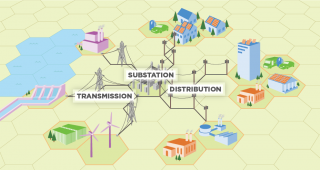Distributed Generation of Electricity and its Environmental Impacts

- About distributed generation
- Distributed generation in the United States
- Environmental impacts of distributed generation
About Distributed Generation
Distributed generation refers to a variety of technologies that generate electricity at or near where it will be used, such as solar panels and combined heat and power. Distributed generation may serve a single structure, such as a home or business, or it may be part of a microgrid (a smaller grid that is also tied into the larger electricity delivery system), such as at a major industrial facility, a military base, or a large college campus. When connected to the electric utility’s lower voltage distribution lines, distributed generation can help support delivery of clean, reliable power to additional customers and reduce electricity losses along transmission and distribution lines.
In the residential sector, common distributed generation systems include:
- Solar photovoltaic panels
- Small wind turbines
- Natural-gas-fired fuel cells
- Emergency backup generators, usually fueled by gasoline or diesel fuel
In the commercial and industrial sectors, distributed generation can include resources such as:
- Combined heat and power systems
- Solar photovoltaic panels
- Wind
- Hydropower
- Biomass combustion or cofiring
- Municipal solid waste incineration
- Fuel cells fired by natural gas or biomass
- Reciprocating combustion engines, including backup generators
Distributed Generation in the United States
The use of distributed generation units in the United States has increased for a variety of reasons, including:
- Renewable technologies, such as solar panels, have become cost-effective for many homeowners and businesses.
- Several states and local governments are advancing policies to encourage greater deployment of renewable technologies due to their benefits, including energy security, resiliency, and emissions reductions.
- Distributed generation systems, particularly combined heat and power and emergency generators, are used to provide electricity during power outages, including those that occur after severe storms and during high energy demand days.
- Grid operators may rely on some businesses to operate their onsite emergency generators to maintain reliable electricity service for all customers during hours of peak electricity use.
Distributed generation systems are subject to a different mix of local, state, and federal policies, regulations, and markets compared with centralized generation. As policies and incentives vary widely from one place to another, the financial attractiveness of a distributed generation project also varies.
As electric utilities integrate information and communications technologies to modernize electricity delivery systems, there may be opportunities to reliably and cost-effectively increase the use of distributed generation.
Environmental Impacts of Distributed Generation
Distributed generation can benefit the environment if its use reduces the amount of electricity that must be generated at centralized power plants, in turn can reduce the environmental impacts of centralized generation. Specifically:
- Existing cost-effective distributed generation technologies can be used to generate electricity at homes and businesses using renewable energy resources such as solar and wind.
- Distributed generation can harness energy that might otherwise be wasted—for example, through a combined heat and power system.
- By using local energy sources, distributed generation reduces or eliminates the “line loss” (wasted energy) that happens during transmission and distribution in the electricity delivery system.
However, distributed generation can also lead to negative environmental impacts:
- Distributed generation systems require a “footprint” (they take up space), and because they are located closer to the end-user, some distributed generation systems might be unpleasant to the eye or cause land-use concerns.
- Distributed generation technologies that involve combustion—particularly burning fossil fuels—can produce many of the same types of impacts as larger fossil-fuel-fired power plants, such as air pollution. These impacts may be smaller in scale than the impacts from a large power plant, but may also be closer to populated areas.
- Some distributed generation technologies, such as waste incineration, biomass combustion, and combined heat and power, may require water for steam generation or cooling.
- Distributed generation systems that use combustion may be less efficient than centralized power plants due to efficiencies of scale.
Distributed energy technologies may cause some negative environmental issues at the end of their useful life when they are replaced or removed.
